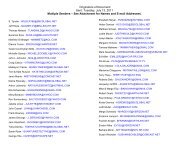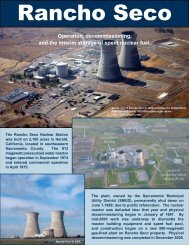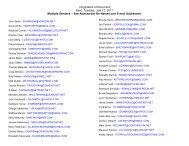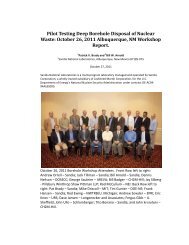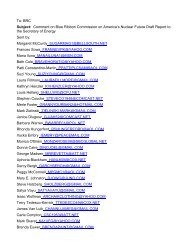Parametric Study of Front-End Nuclear Fuel Cycle Costs Using ...
Parametric Study of Front-End Nuclear Fuel Cycle Costs Using ...
Parametric Study of Front-End Nuclear Fuel Cycle Costs Using ...
Create successful ePaper yourself
Turn your PDF publications into a flip-book with our unique Google optimized e-Paper software.
<strong>Front</strong>-<strong>End</strong> <strong>Nuclear</strong> <strong>Fuel</strong> <strong>Costs</strong><br />
recycling at the end <strong>of</strong> 2003 and that an additional 7,096 MTU <strong>of</strong> RepU would be separated<br />
through reprocessing LWR spent fuel between 2004 and 2010. 4<br />
To date, RepU from LWR spent<br />
fuel has been recycled in nuclear power plants in Belgium, France, Germany, Japan, the<br />
Netherlands, Sweden, and Switzerland.<br />
In addition, the IAEA estimates that 53,000 to 55,000 MTU <strong>of</strong> RepU had been separated from<br />
non-LWR spent fuel through 2003 and that approximately 20,000 MTU <strong>of</strong> this non-LWR<br />
derived RepU was still available for recycle. RepU from non-LWR spent fuel has been recycled<br />
into nuclear power plants in the United Kingdom (U.K.). IAEA estimates also indicate that a<br />
further 15,000 MTU <strong>of</strong> RepU would be separated through reprocessing <strong>of</strong> non-LWR spent fuel<br />
through 2010. 5<br />
Thus, the quantities <strong>of</strong> RepU that are available now and that may be available for<br />
recycle in the future could displace a relatively small quantity <strong>of</strong> natural uranium in the fuel<br />
cycle, assuming that it is technically and economically feasible to utilize this RepU.<br />
<strong>Using</strong> the data from the 2007 IAEA report, a study published in the June 2006 RWE NUKEM<br />
Market Report, entitled RepU’s Second Chance, estimated that existing inventories <strong>of</strong> RepU<br />
could displace 15,300 to 15,900 MTU <strong>of</strong> natural uranium feed and the future annual RepU<br />
arisings could displace up to an additional 2,300 MTU <strong>of</strong> natural uranium feed annually in the<br />
future – approximately 3.5% <strong>of</strong> then-current worldwide annual uranium requirements. 6<br />
With<br />
worldwide nuclear power plant capacity poised to begin expanding, the use <strong>of</strong> RepU to displace<br />
natural uranium feed may help reduce future gaps between uranium supply capacity and<br />
worldwide uranium requirements.<br />
Through the parametric analysis <strong>of</strong> front-end fuel cycle costs associated with the use <strong>of</strong> RepU in<br />
LWR fuel, this report identifies those front-end fuel cycle cost components that may be factors in<br />
determining the economic feasibility <strong>of</strong> RepU recycling on an expanded basis.<br />
The IAEA (2007) also identifies other technical and regulatory issues associated with recycling<br />
RepU such as possible reactor license amendments to utilize RepU fuel; qualification and<br />
benchmarking <strong>of</strong> reactor core physics codes to account for the use <strong>of</strong> RepU fuel; and the<br />
potential need for design and certification <strong>of</strong> new transport packages for enriched RepU and<br />
fabricated RepU fuel. 7<br />
This report does not attempt to address these issues or assess the costs <strong>of</strong><br />
addressing these potential technical and regulatory issues on the economic competitiveness <strong>of</strong><br />
recycling RepU.<br />
4<br />
IAEA (2007), Table 24, p. 53.<br />
5<br />
IAEA (2007), Table 25, p. 54.<br />
6<br />
RWE NUKEM, RWE NUKEM Market Report Online, RepU’s Second Chance, June 2006, pp. 9-10. [NUKEM<br />
(2006)]<br />
7<br />
IAEA (2007), Section 4.2.1, Section 6.<br />
1-3



![Rainer Schottlaender[SMTP:RAINER.SCHOTTLAENDER@WEB.DE]](https://img.yumpu.com/51418350/1/190x245/rainer-schottlaendersmtprainerschottlaenderwebde.jpg?quality=85)
